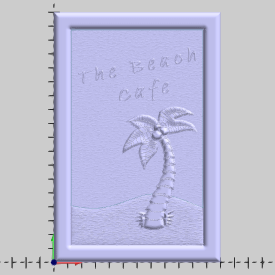
This help topic explains how to create an Emboss Texture Weave feature. In this example, a weave texture is applied to the background of a sign that was created using an Emboss from Component feature.
The BobCAD part file for this tutorial is available for download at: http://www.bobcad.com/helpfiles. If you are connected to the Internet, you can click the link provided to download and save the Emboss Texture Weave Example 1.bbcd zip file. After downloading the zip file, extract the files on your system in a place that is easy to remember. You can then open the BobCAD file (.bbcd) to use with this tutorial.
The component (sign) used for this tutorial is shown next. The stock is the same size as the component, which has already been created in the example file.

1 In the File menu, click Open.
2 In the Open dialog box, select the folder in which you extracted the example file.
3 Select Emboss Texture Weave Example.bbcd, and click Open.
4 In
the Data-CAM Tree Manager, click
the ![]() BobART Manager
tab.
BobART Manager
tab.
5 Next
to ![]() Emboss Model,
click
Emboss Model,
click  to expand the tree.
to expand the tree.
Notice that the ![]() Beach Cafe Sign
feature already exists.
Beach Cafe Sign
feature already exists.
1 In
the ![]() BobART
tree, right-click
BobART
tree, right-click ![]() Emboss Model.
Emboss Model.
Point to Emboss Texture, and click Weave.
2 In the Texture-Weave dialog box, in the Emboss Attributes group, click Color.
In the Color dialog box, click a color for the feature, and click OK. (This example uses a brown color.)
3 In the Name box, select the text, and type My Weave.
4 To close the dialog box, click OK.
The ![]() My Weave feature is added to the
tree.
My Weave feature is added to the
tree.
5 In
the ![]() BobART
tree, right-click
BobART
tree, right-click ![]() Emboss Model,
and click Regenerate.
Emboss Model,
and click Regenerate.
The new feature is added to the embossed model in the Workspace.
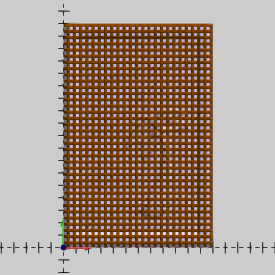
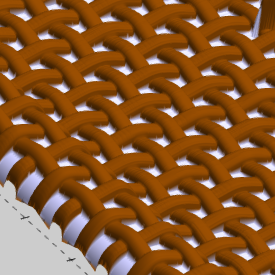
When no Boundary Geometry is assigned for the feature, the texture-weave is applied to the entire model. (A boundary is selected later in this example.)
In addition to the fact that no boundary has been defined, the selected Application Type, Add, causes the feature to be added to the other existing feature. This is changed in the next part.
1 In
the BobART tree, right-click ![]() My Weave, and
click Edit.
My Weave, and
click Edit.
2 In the Texture-Weave dialog box, click the Application Type arrow, and click Merge High.
3 To close the dialog box, click OK.
4 To update the changes on the model, right-click Emboss Model, and click Regenerate.
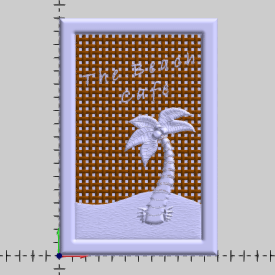
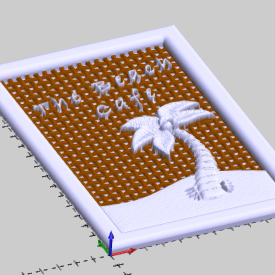
The Merge High application type keeps only the highest portion of the model. Because the total height of the weave is less than the total height of the component, the weave is now only contained in the area of the model that is less than the height of the weave.
In this section, you change the cross-section shape to see how the cross section is applied to the weave. To better view the cross-section shape, we suppress the sign so that only the weave is shown.
1 In
the BobART tree, right-click ![]() Beach Cafe Sign,
and click Suppress/Unsuppress.
Beach Cafe Sign,
and click Suppress/Unsuppress.
2 Right-click Emboss Model, and click Regenerate. Now only the weave is visible.
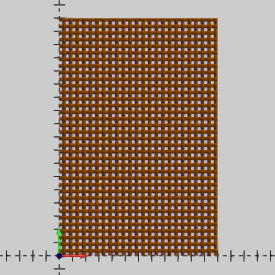
When the view is rotated, the cross-section shape is easier to view. The following images compare the cross section defined in the Texture-Weave dialog box to the result on the model.
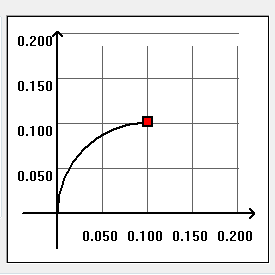
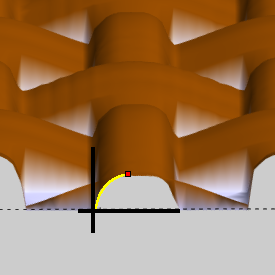
3 In
the BobART tree, right-click ![]() My Weave, and
click Edit.
My Weave, and
click Edit.
4 In the Cross-Section Shape group, click the Shape Style arrow, and click Concave Arc.
5 To close the dialog box, click OK.
6 Right-click Emboss Model, and click Regenerate.
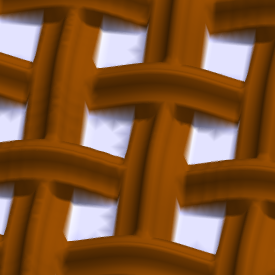
The following images compare the cross section defined in the Texture-Weave dialog box to the result on the model.
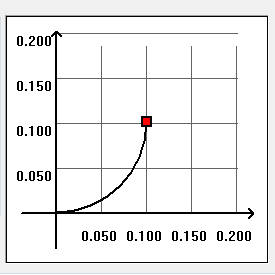
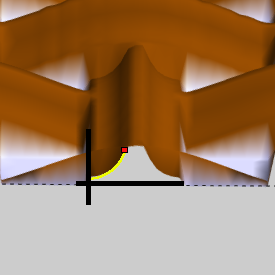
About the Cross-Section Shape Total Width:
The Total Width parameter in the Texture-Weave dialog box defines the width of each row/column of the weave. Generally, in order to create predictable results, the Total Width should be at least twice the width of the cross section (for example, the Radius or Major Axis). The following examples both use a cross-section Radius of 0.100. The Total Width of 0.250 allows the cross-section shape to be fully defined across each row/column of the weave. The Total Width of 0.125 does not create the same result. A portion of the cross-section shape is removed to fit the defined Total Width. (The Drive Curve-Peak Length parameter, explained in Part 5, also affects the result.)
Total Width 0.250 |
Total Width 0.125 |
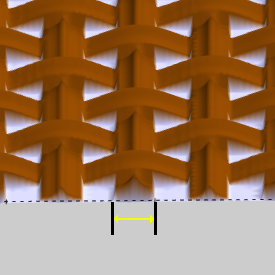 |
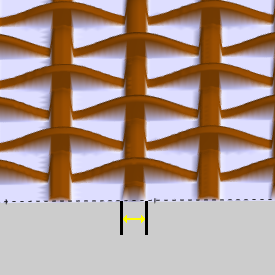 |
The previous information is a recommendation and may not always be followed.
1 Right-click My Weave, and click Edit.
2 In
the Driving Curve Shape group,
click to clear the  Smooth
Curve check box.
Smooth
Curve check box.
This makes the weave appear as the straight-line Driving Curve Shape that is displayed in the Texture-Weave dialog box.
In the Cross-Section Shape group, click the Shape Style arrow, and click Convex Arc.
To close the dialog box, click OK.
3 Right-click Emboss Model, and click Regenerate.
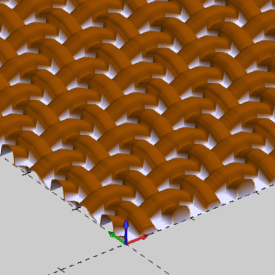
4 Right-click My Weave, and click Edit.
In the Driving Curve Shape group, change the Length to 1.000, and change the Z Height to 0.250.
Click OK to close the dialog box.
5 Right-click Emboss Model, and click Regenerate.
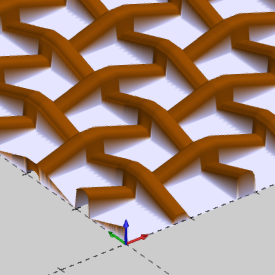
The previous settings make it easier to see the result of the defined drive curve parameters, Length (1) and Z Height (2), as shown next.
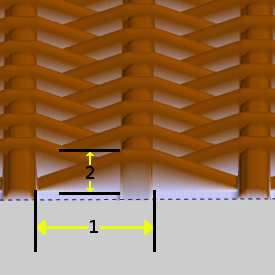
When the Peak Length (3) is changed to 0.500, the result is as follows.
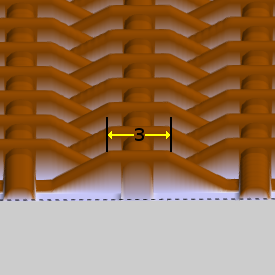
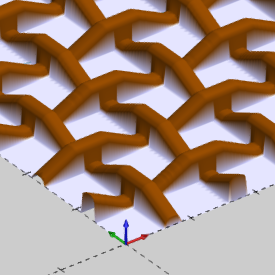
TIP: The Peak Length shown in the previous steps was increased from 0.250 to 0.500. This means that the Total Width of the Cross Section Shape can now also be increased up to 0.500 (and still create predictable results). Again, this is a recommendation that may not always be followed. (For example, you may want to set the Total Width greater than the Peak Length if it creates desired results.)
1 In the BobART tree, right-click Beach Cafe Sign, and click Suppress/Unsuppress.
2 Right-click Emboss Model, and click Regenerate.
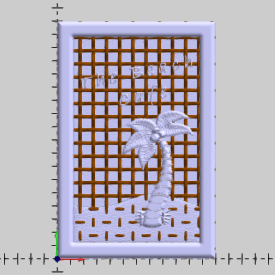
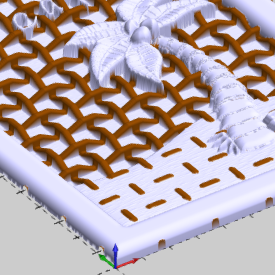
The currently defined parameters cause the texture to appear in an area of the model that is not desired. To contain a texture, you assign a boundary.
3 Under
My Weave, right-click ![]() Boundary
Geometry, and click Re/Select.
Boundary
Geometry, and click Re/Select.
Because selection mode is now active, the Workspace has key focus. To hide the embossed model, press the keyboard shortcut E.
Press and hold Shift, and click any entity as shown next.
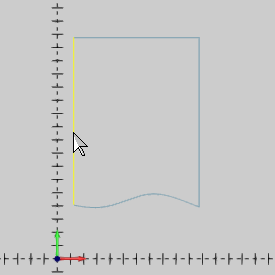
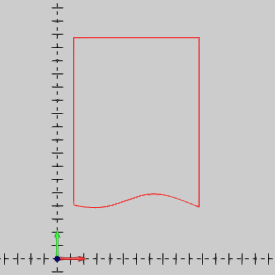
To confirm the selection, click ![]() OK. (You can also press the Spacebar.)
OK. (You can also press the Spacebar.)
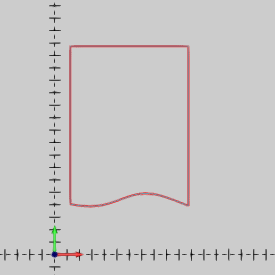
4 To show the embossed model, right-click Embossed Model, and click Blank/Unblank.
To update the model, right-click Embossed Model, and click Regenerate.
The texture is now contained within the selected boundary.
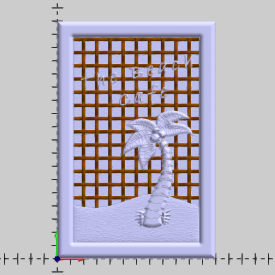
For the final part of this example, the weave is edited to form a solid background texture for the sign.
1 Right-click My Weave, and click Edit.
2 In the Driving Curve Shape group:
Set the Length to 0.500.
Set the Z Height to 0.100.
Set the Peak Length to 0.250.
Click to select the  Smooth
Curve check box.
Smooth
Curve check box.
3 In the Cross-Section Shape group:
Set the Total Width to 0.500.
Click the Shape Style arrow, and click Line.
Set the Height to 0.100, and set the Slope Angle to 90.00.
Click OK to close the dialog box.
4 Regenerate the model.
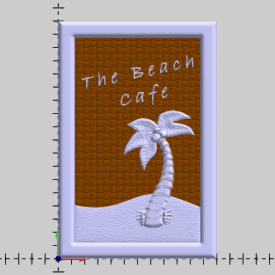
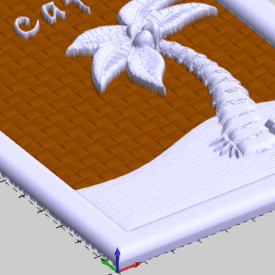
Because the Cross-Section Shape-Total Width parameter is the same value as the Driving Curve Shape-Length parameter, the weave no longer contains any space between each row/column.
When you Edit the feature and change the Rotation Angle to 22.00, the regenerated result is as follows. (The rotation angle is measured from the X-axis.)
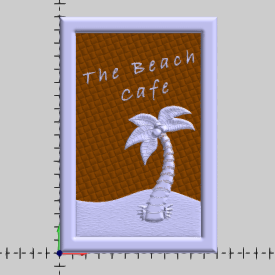
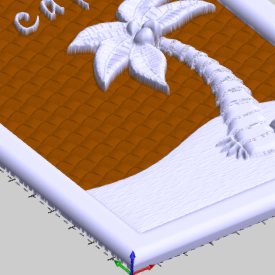
This concludes the tutorial.